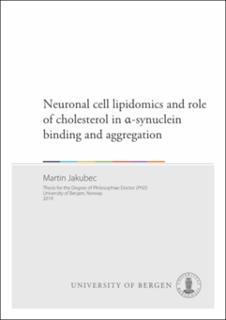| dc.contributor.author | Jakubec, Martin | |
| dc.date.accessioned | 2019-04-11T08:56:06Z | |
| dc.date.available | 2019-04-11T08:56:06Z | |
| dc.date.issued | 2019-03-22 | |
| dc.identifier.uri | http://hdl.handle.net/1956/19317 | |
| dc.description.abstract | α-Synuclein is an intrinsically disordered protein whose fold and multimeric state is strongly affected by its environment. The monomers of α-synuclein are enriched in the presynaptic terminals of dopaminergic neurons and seem to have a role in synaptic vesicles recycling and transmitter release. Specific cellular conditions can promote α-synuclein oligomerization which, in the end, results in neuronal death. Lipids seem to be one of these conditions as they are involved in both the native and pathogenic role of α-synuclein. This thesis aims to explore α-synuclein:lipid interaction and how binding to certain lipids may trigger or suppress oligomerization. Furthermore, it aims to establish and use lipidomic techniques for improving the state of knowledge of the lipid environment that might affect α-synuclein function and dysfunction. In Paper I we investigated how cholesterol, the most abundant lipid in mammals, affect α-synuclein affinity towards the lipid bilayer and its oligomerization properties. For this work we tested and optimized the preparation of SMA lipid nanodiscs containing cholesterol. Then, we used these nanodiscs to investigate lipid-mediated changes in fibrillation. We also determined individual amino acid affinities towards the lipid bilayer within the α-synuclein primary sequence. The results suggest the existence of two binding modes: the N-terminal and NAC binding mode. The N-terminal mode seems to be preferred in the presence of anionic lipids (like PG), and this binding leads to a delay in fibrillation onset. The NAC-binding mode seems to be promoted in the presence of lipid bilayers containing cholesterol and speed up α-synuclein oligomerization significantly. In Paper II, we focused on lipidomics methods. We established and optimized a method for lipid isolation, followed by phospholipid identification and quantification using 31P NMR. These methods were first tested on populations of a prokaryotic organism, L. innocua, which were arrested at the C/D boundary of its cell cycle. We discovered that L. innocua modulates its lipid composition, and both cardiolipin and phosphatidylethanolamine fall significantly between the B period and the C/D boundary. When we investigated how these lipid changes could affect the physical properties models of the cell membrane, we observed that the decrease of PE content seems to be compensated for by an increase of PG. In the absence of other factors, this would result in decreasing stored curvature stress, while maintaining membrane fluidity. In Paper III, we used methods established in Paper II for the lipidomic analysis of the SH-SY5Y cell line, which is a commonly used neuronal cell model for Parkinson’s disease research. We also developed an automated script for analysis of the fatty acid chain distribution of phospholipids by LC-MS/MS. We observed several deviations of lipid content from commonly used lipid models and lipid content of brain matter. The most interesting ones are a high content of PC, low content of SM and PS and absence of longer fatty acid chains, including 22:6 PS. | en_US |
| dc.language.iso | eng | eng |
| dc.publisher | The University of Bergen | en_US |
| dc.relation.haspart | Paper I: Jakubec M., Furse S., Bariås E., Govasli M. L., George V., Turcu D., Morozova-Roche L., Halskau Ø. Cholesterol is a strong promotor of an α-Synuclein membrane binding mode that accelerates oligomerization. The FEBS Journal. 2021, 288 (6), 1887-1905. The article is available at: <a href="https://hdl.handle.net/11250/2756380" target="blank">https://hdl.handle.net/11250/2756380</a> | en_US |
| dc.relation.haspart | Paper II: Furse S., Jakubec M, Rise F., Williams H.E., Rees C.E.D., Halskau Ø. Evidence that Listeria innocua modulates its membrane's stored curvature elastic stress, but not fluidity, through the cell cycle. Scientific reports, 7, 8012, 2017. The article is available at: <a href="http://hdl.handle.net/1956/19316" target="blank">http://hdl.handle.net/1956/19316</a> | en_US |
| dc.relation.haspart | Paper III: Jakubec M., Bariås E., Kryuchkov F., Hjørnevik L. V., Halskau Ø. Fast and quantitative phospholipidomic analysis of SH-SY5Y neuroblastoma cell cultures using LC-MS/MS and 31P NMR. ACS Omega. 2019, 4, 21596–21603. The article is available at: <a href="https://hdl.handle.net/1956/23182" target="blank">https://hdl.handle.net/1956/23182</a> | en_US |
| dc.rights | Attribution CC BY | eng |
| dc.rights.uri | http://creativecommons.org/licenses/by/4.0/ | eng |
| dc.title | Neuronal cell lipidomics and role of cholesterol in α-synuclein binding and aggregation | en_US |
| dc.type | Doctoral thesis | |
| dc.rights.holder | Copyright the author | en_US |
| dc.identifier.cristin | 1689701 | |

